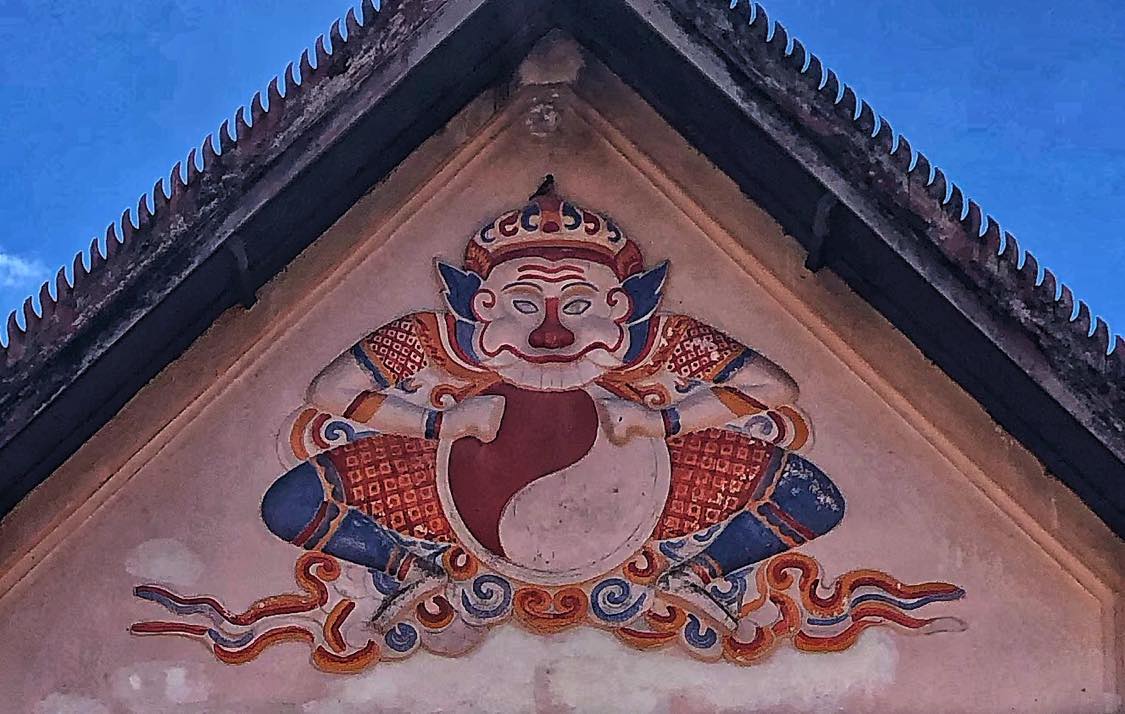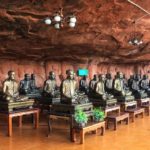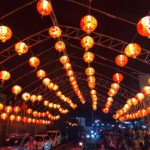Pangu: Chinese Mythology in Thailand

While there are millions of citizens of Thailand who have Chinese ancestry, the depiction of Chinese mythological characters at Thai temples is rare, except at Chinese Buddhist temples that serve the Chinatown area of a particular province. It is even less common in the Northeast of Thailand (Isaan), where there are fewer Chinese communities, the region being most heavily influenced by its Lao ancestry.
In fact, during our visits to over 200 Thai temples in Sakon Nakhon and Isaan, we had yet to see a Chinese mythological figure, except for Guanyin, the Bodhisattva of Compassion or Goddess of Mercy. However, the Guanyin figure is not exclusively Chinese, having been derived from the Indian Bodhisattva Avalokitesvara, who goes by the name Phra Mae Kuan Im (พระแม่กวนอิม) in Thailand.

However, all that changed yesterday when visiting Wat Phra That Si Mongkhon, whose spired pagoda houses gold and bronze relics of the Buddha which were unearthed in 1901. At this temple, about 1 hour northwest of Sakon Nakhon, we discovered a shrine built in 1947 whose outer wall is decorated with the Chinese mythological figure Pangu, the god of creation. Pangu’s image was depicted in classic Isaan folk style but we could tell it was meant to be Pangu, as he was holding the Yin and Yang symbol, which is not associated with any Thai religious traditions, but only ancient Chinese mythology.
According to the Chinese creation myth, in the beginning, there was chaos, and the universe was a vast, dark, and featureless void. In this void, there was a cosmic egg, and within it, the primordial god Pangu was formed. Pangu grew rapidly, and as he grew, he expanded the egg, pushing apart the yin and yang energies, which had been in a state of balance within the egg.
After 18,000 years, Pangu was strong enough to break the eggshell, and he emerged, creating the sky and the earth. Then he set about separating the yin and yang energies, which had become mixed together during his growth. Pangu used his axe to cut a passage between them, and he placed himself in the middle, holding up the sky above and standing on the earth below.
He continued to grow for another 18,000 years, gradually pushing the sky higher and the earth lower, until they were separated by a vast distance. As he worked, Pangu eventually grew tired and laid down to rest. He never woke up, and his body slowly transformed into the natural features of the earth, such as mountains, rivers, and forests.
The yin and yang symbol is thus a representation of the two complementary and opposing energies of the universe. It represents the idea that everything in the universe contains both yin and yang energies and that balance and harmony can be achieved by recognizing and respecting their interdependence half. It represents the idea that everything in the universe contains both yin and yang energies and that balance and harmony can be achieved by recognizing and respecting their interdependence.
- Affirmations in Buddhism & Thailand - June 7, 2025
- Speak Thai Naturally Without the Gymnastics - April 20, 2025
- The Best Learn Thai Podcast and YouTube Channel - April 10, 2025





